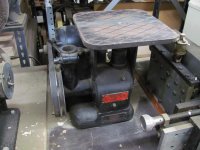Also, can you explain the purpose of the finger rest please? I had assumed it was an attachment for stopping the work from lifting when using conventional files.
Give the man a ceegar! You assumed correctly. But it is not just for conventional files, but all files used in the machine.
The finger-rest is adjusted over the piece being filed to prevent the file from pulling it from the table top on the up stroke. Parallel files, the type of file used in die filers, are cut "backward", meaning that if you hold the uncut tang portion in your hand, you would have to push the file to get it to cut. Therefore, when installing a file into a die filer, the tang goes into the clamp on the overarm, while the other end attaches to the pitman.
Thus, in operation, the file cuts on the downward stoke, applying the pressure of the cut towards the table. Nevertheless, there is still sufficient frictional force on the back side of the file teeth to lift a workpiece from off the table on the return. The finger prevents this "sucking" action.
You do not want, if at all possible, to file a part without the finger in place. These little puppies WILL pull up a part, and slam it down, repeatedly, on the hapless phalange the always finds it's way betwixt the piece part and the table.
I know from experience. It ain't pleasant.
By the way Peter, that is an adorable little filer. I rarely use my Oliver, but when I do, I am always wondering what I would do without it. Die filers are damned handy tools to have around.
J.D.














